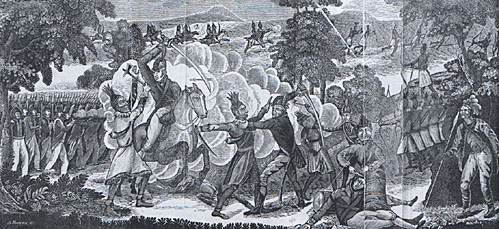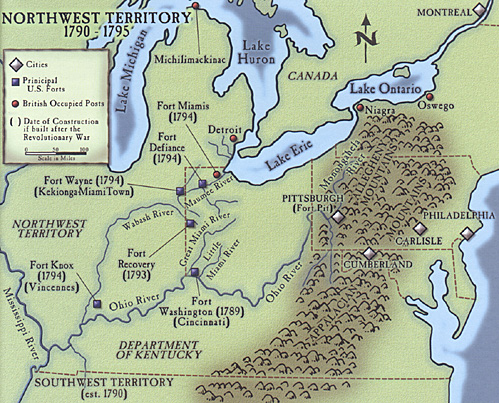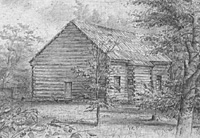Introduction
 All wars, given time, become civil wars.
All wars, given time, become civil wars.
- --Voltaire
Following victory and independence from British rule in the Revolutionary War, the United States was faced with a host of issues and challenges. Not the least of these were those arising from the western territories, particularly the area north and west of the Ohio River. How a nation governs its citizens, fosters economic growth and prosperity, as well as defining and protecting its national interests are vital to° its success or failure. The new nation and its first president learned hard lessons along those lines in the Ohio frontier.
The Ohio River valley and lands adjacent to Lake Erie were always popular with the residents of the North American continent. Archaeological evidence points to early human habitation over fifteen thousand years ago. The Adena people, named for the site in Ohio where the first traces of this culture were identified, built extensive effigy mounds throughout the territory. Among their descendants may be the Aztecs, whose origin tales speak of migrating from the north, and who worshipped a snake-like god like the Adena did. Another prehistoric culture that flourished in the Ohio territory was that of the Hopewell people.
Extensive traders of pottery, they lived in large communities, built fort-like enclosures, and buried their dead in large burial mounds, some pyramid-like in shape. The Ohio territory supported these native residents with large numbers of wildlife such as bison, elk, and deer as well as small game. Well-watered by numerous rivers and tributaries, the land was well suited to the subsistence level cultivation used by these semi-nomadic peoples.
The early 17th century brought the first Europeans to Ohio. For the most part it would be French explorers and fur traders who engaged the native Algonquian-speaking people in supplying the highly sought-after beaver, fox, and raccoon pelts for fashion designers back in Paris. English traders and explorers provided increasing competition and sources of dispute as Great Britain's thirteen colonies grew. Among the native residents (Shewanese, or "the People") of the Ohio region the Europeans trafficked with were the Shawnee, Miami, Wyandot, Ottawa, Mingo and Delaware nations. Others, such as Sauks, Potowatomi, and Iroquois also occasionally hunted and lived in the area, sometimes at great peril from the native inhabitants, who guarded their hunting grounds zealously.
 BLOODY OHIO
BLOODY OHIO
The Ohio territory was the scene of bloodshed and fighting even before the United States of America gained titular control of the region. The Iroquois fought numerous wars and raids with the other natives for control of the area's resources. The increased demands by Europeans for furs fueled much of this conflict, but the displacement by American colonists' quest for farmland of other Native Americans, the Delaware in addition to the Iroquois, also contributed to these outbreaks of violence. Racism and the religious intolerance of the age led to frequent clashes between colonists and Indians, and a -growing unwillingness by many Americans to settle differences amicably. As one historian put it, "genocide was the unmistakable, if inadvertent, consequence of the forward thrust of colonial American civilization among the native populations." [1]
Conflict among the Europeans, either arising from events across the Atlantic as well as disagreements over who "owned" what land in the colonies, eventually influenced events in the lands bordering the Ohio River. In 1753 a young George Washington lead a party to survey the border between the Crown colony of Pennsylvania and then French-controlled Ohio. The construction of Fort Duquesne by the French at the confluence of the Monongahela and Allegheny Rivers where they formed the Ohio (present day Pittsburgh), in an area claimed by the British, eventually led to the start of the French and Indian War in 1755, also known as the Seven Years War in Europe (1756-1763). This global conflict eventually drew in all of the major powers of Europe with fighting in India as well as North America, and resulted in the establishment of Great Britain's worldwide empire that would last over 150 years.
England's victory in 1763 in the Seven Years War, with control over the Ohio territory, would prove to be short-lived and a major cause for the thirteen American colonies' demands for independence. Desperately short of funds, deep in debt, and confronted with increasing costs in maintaining a far-flung empire, Great Britain could ill-afford an extensive military presence in the newly acquired territories to support and protect American ambitions west of the Appalachian Mountains.
The taxes imposed upon the colonists to pay for the costs incurred in the war were onerous enough, but Great Britain's prohibition of settlement in the western lands under the Intolerable Acts led to the outbreak of Revolution in 1776.
For nearly a hundred years, warnings from their eastern neighbors, the Iroquois, as well as the French, about the British Colonists' (and later America's) greed for land were heard by the natives of Ohio. Almost a century earlier Metacomet (King Philip) warned,
"Brothers, you see the foe before you. That they have grown insolent and bold. That all our ancient customs are disregarded; the ,treaties made by our fathers and us are broken and all of us insulted.. . Brothers, these people from the unknown world will cut down our groves, spoil our hunting and planting grounds, and drive us and our children from the graves of our fathers..." [1]
However, most leaders of the Native American nations of Ohio were indifferent to white (Shemanese, also called "Long Knives") ambitions before the Revolution, expressing equal amounts of either contempt or disdain for the revolutionaries as well as the British. Once the United States was formed, and the new nation's ambitions in the west became more distinct, attitudes among the native inhabitants quickly changed. The people who threatened to take away their lands were no longer from an unknown distant land, but neighbors just a few days' or weeks' journey away.
A clear policy of what to do with the lands west of the Appalachian Mountains was long in the making by the new United States Government. South of the Ohio River in the Kentucky Territory, Virginia had a clear claim and title to the land. Thanks to the efforts of such early explorers as Daniel Boone, who cleared trails through the wilderness, settlements quickly sprang up in that region even before the Revolutionary War formerly ended in 1783. The territory north of the Ohio River was more problematic, even disregarding the claims and rights of the native inhabitants. New York, Connecticut, Virginia as well as Pennsylvania all had competing claims on the land. No settlements would be permitted in Ohio by the federal government until these rival concerns were settled. Those politicians who did bring up reservations or concerns for the Indians already living there were not well received. Secretary of War Henry Knox ran into a storm of criticism when in July 1789 he stated the Indians had right of possession to their lands, and that only the purchase or conquest in a just war could deny them their claims. [3]
While some of the Native American nations remained neutral in the earlier wars, or even sided with the colonists, many Americans held to the belief that all Indians were the same, and the "right of conquest" resulting from the revolution nullified any earlier arrangements made regarding the Ohio territory.
With the passage of the Northwest Ordinance in 1787, the only legislation passed under the Articles of Confederation, the means of American settlement for Ohio was put into place. The entire region was to be surveyed and sections set aside for the various claimants. For example, those who suffered losses due to British raids in Connecticut during the Revolutionary War were given parcels in the "Fire Lands" in the northeastern corner of the territory. The Western Reserve lands were given out as payment to veterans who fought in the war. Others who lent money to Congress received payment in the form of land as well. Speculators did a "land office" business (perhaps the origin of the phrase is from this era) in buying up and then reselling these allotments to those eager at starting a new life out west.
Even before the passage of the Northwest Ordinance American citizens began moving, albeit illegally, into the lands north and west of the Ohio River. John Cleve Symmes, a New Jersey congressman, purchased from French traders titles for land between the Scioto and Great Miami Rivers north of the Ohio River, in the heart of the Miami nation, as well as some territory that was claimed by the Shawnee. Unscrupulous land developers sold counterfeit deeds, just across the river from Virginia, adding to the confusion and sense of "land grabbing" that grew with each passing' year. President Washington somewhat optimistically, even naively, believed the vast expanse of land offered a peaceful means of accommodation. Shortly after his inauguration on April 30, 1789 he wrote "There is nothing to be obtained by an Indian war, but the soil they live on, and this can be had by purchase at less expense, and without bloodshed."
[4]
At the same time, however, General Josiah Harmar was ordered from Kentucky to construct a fort along the north bank of the Ohio, near present-day Marietta, to prevent the further trespass of Indian lands, and to protect those who were settling legally (at least from the US point of view) in Kentucky, traveling, there by boat down the Ohio River. Also sent to govern the new Ohio Territory, and arrange a peaceful accommodation with the natives, was Arthur Saint Clair.
A Dark and Bloody Ground The Ohio Campaign 1790-1795
 MANIFEST DESTINY?
MANIFEST DESTINY?
Introduction
War in Ohio
Wayne Takes Command
Dramatis Personae
US and Indian Forces
Map of Battle of Fallen Timbers (very slow: 209K)
Back to Table of Contents -- Against the Odds vol. 2 no. 3
Back to Against the Odds List of Issues
Back to MagWeb Magazine List
© Copyright 2004 by LPS.
This article appears in MagWeb.com (Magazine Web) on the Internet World Wide Web.
Other articles from military history and related magazines are available at http://www.magweb.com
* Buy this back issue or subscribe to Against the Odds
direct from LPS.
